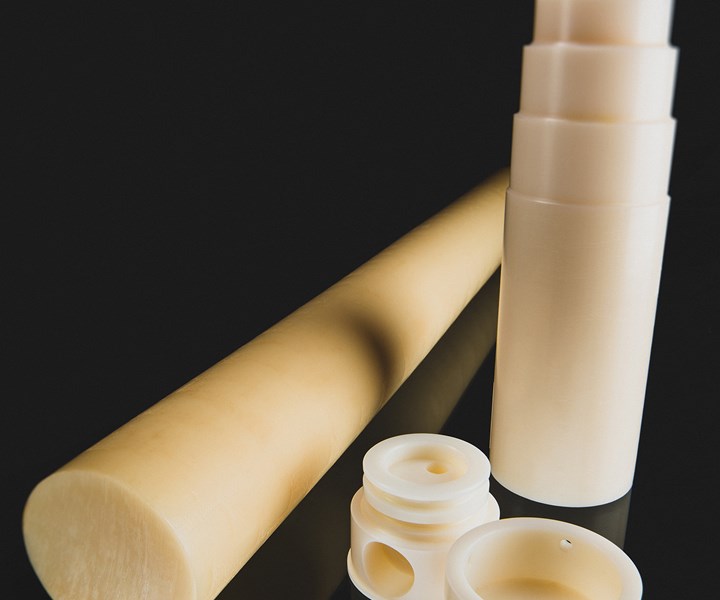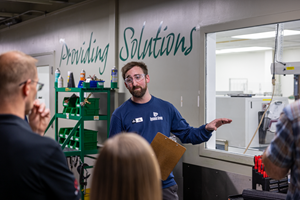Materials: Advanced PPA Meets Extrusion Processing Demands
BASF’s Ultramid Advanced N5H UN PPA boasts easy extrusion and is newly featured on what’s likely the first semi-finished PPA part.
A high-temperature resistance PPA that can be easily manufactured into semi-finished parts by extrusion in newly available fromBASF Corp., Florham Park, N.J. According to the company, commercial PPAs have been difficult to extrude for several reasons including the need for the right melt viscosity and melt temperature for processing to achieve a stable production. Said a BASF spokesman, “The material has to withstand the needed residence time. Said a BASF spokesperson. “During cooling down, no voids should show up inside the cooled semi-finished part. We developed our new PPA material to meet all these processing demands.”
New Ultramid Advanced N5H UN PPA was recently used in what may well be the first semi-finished part made of PPA by Germany’s GEHR, which produced extruded stock shapes with a diameter of 50 millimeters (1.96 in.). The material reportedly offers excellent mechanical properties at elevated temperatures due to its semi-aromatic chemical structure. It also shows excellent resistance to chemicals and hydrolysis, even in aggressive environments, as well as good sliding friction properties--and all this at temperatures above 100 C (212 F). Due to its low water uptake, its mechanical properties remain stable over a wide temperature range. Even in humid environments, the long-chain high-performance material shows a dimensional stability that belongs to the highest of all nylons.

This property profile is said to make Ultramid Advanced N the perfect material for extruding pre-fabricated components and small assemblies but also for many applications in the automotive industry, in mechanical engineering and in kitchen appliances. During machining, the behavior of the semi-finished products lies between a nylon and a polyoxymethylene copolymer (POM), with steady and consistent chip formation and removal. A wide range of applications can be manufactured from GEHR’s extruded rods: Components with very high operating temperatures and pump parts requiring exact dimensional stability are just as feasible as gear wheels, thermostat housings and sliding rails. In the automotive industry, the material is particularly suitable for components that come into contact with motor and transmission oils, coolants, acids, salts and de-icing fluids. Parts that require high sliding friction properties can be used even at high temperatures due to the material’s high impact resistance and very low wear rate.
Said Philipp Wenz, group head in sales of BASF’s Performance Materials division “GEHR is the first company to successfully use a PPA for extrusion. With its expertise in extrusion, GEHR has developed stock shapes that can be produced without any voids. We can't say for certain whether it’s the world’s first semi-finished part made from polyphthalamide. But, the high-performance material has definitely not yet played an important role in the market for semi-finished parts. One reason for this might be that usual polyphthalamides cannot be extruded very well.” As such Ultramid Advanced N5H is said to close a gap in the market between semi-finished parts made of polyetheretherketones (PEEK) and polyarylsulfones (PES) on the one hand and semi-finished products made from engineering plastics on the other hand. In comparison to the latter it can be used at continuous operating temperatures well above 120 C/248 F). The BASF material is also suitable for profiles other than rods.
Related Content
How to Extrusion Blow Mold PHA/PLA Blends
You need to pay attention to the inherent characteristics of biopolymers PHA/PLA materials when setting process parameters to realize better and more consistent outcomes.
Read MoreMedical Molder, Moldmaker Embraces Continuous Improvement
True to the adjective in its name, Dynamic Group has been characterized by constant change, activity and progress over its nearly five decades as a medical molder and moldmaker.
Read MoreFormulating LLDPE/LDPE Blends For Abuse–Resistant Blown Film
A new study shows how the type and amount of LDPE in blends with LLDPE affect the processing and strength/toughness properties of blown film. Data are shown for both LDPE-rich and LLDPE-rich blends.
Read More‘Monomaterial’ Trend in Packaging and Beyond Will Only Thrive
In terms of sustainability measures, monomaterial structures are already making good headway and will evolve even further.
Read MoreRead Next
Troubleshooting Screw and Barrel Wear in Extrusion
Extruder screws and barrels will wear over time. If you are seeing a reduction in specific rate and higher discharge temperatures, wear is the likely culprit.
Read MoreProcessor Turns to AI to Help Keep Machines Humming
At captive processor McConkey, a new generation of artificial intelligence models, highlighted by ChatGPT, is helping it wade through the shortage of skilled labor and keep its production lines churning out good parts.
Read MorePeople 4.0 – How to Get Buy-In from Your Staff for Industry 4.0 Systems
Implementing a production monitoring system as the foundation of a ‘smart factory’ is about integrating people with new technology as much as it is about integrating machines and computers. Here are tips from a company that has gone through the process.
Read More









.png;maxWidth=300;quality=90)













